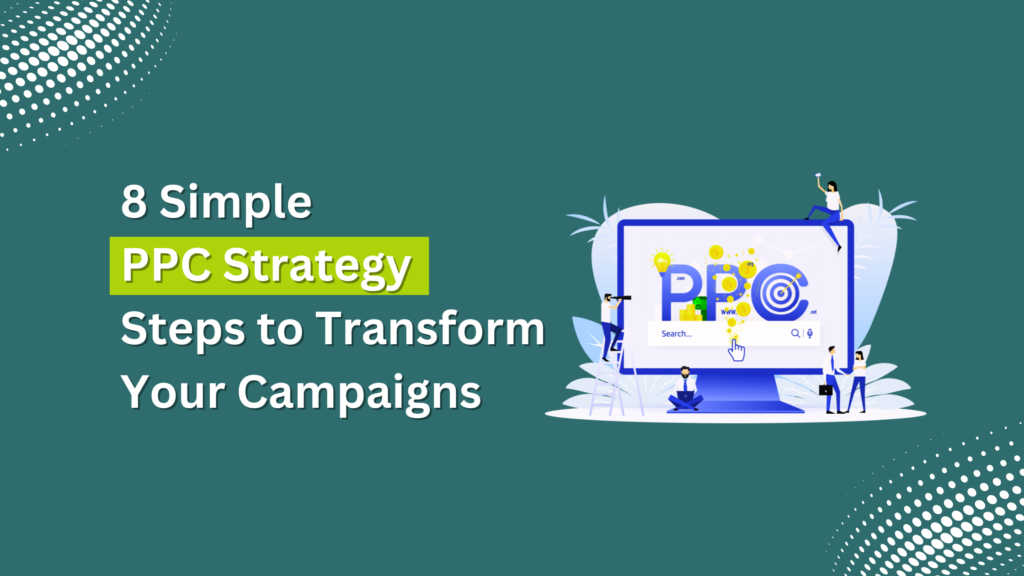8 Simple PPC Strategy Steps to Transform Your Campaigns
Are you tired of pouring money into PPC campaigns without seeing the results you expect? You’re not alone. Countless businesses invest in PPC in marketing only to feel frustrated by the lack of tangible outcomes. But what if there was a way to turn your campaigns around with just a few simple yet effective tweaks? Imagine transforming your pay-per-click efforts into a powerhouse that drives quality traffic, boosts conversions, and maximizes ROI. The secret lies in mastering the art of PPC strategy. In today’s fast-paced digital landscape, it’s easy to get lost in a sea of strategies and advice. However, achieving PPC success doesn’t require complex methods or astronomical budgets. By focusing on just 8 simple PPC strategy steps, you can refine your campaigns and start seeing real progress. Whether you’re a seasoned marketer or just dipping your toes into the world of marketing tactics like PPC, these steps will equip you with the tools to take control of your ad spend and turn it into meaningful results. So, what makes this approach different? It’s not about reinventing the wheel. It’s about precision—optimizing the small details that add up to significant improvements. From choosing the right keywords to refining your ad copy, each of these steps will help you fine-tune your strategy for peak performance. The beauty of these actionable steps lies in their simplicity. No need for guesswork, no need for advanced technical skills—just clear, strategic adjustments that will set your campaigns on the path to success. Now, imagine watching your ad spend work harder for you. Picture your ads appearing in front of the right audience at the right time, your quality leads turning into conversions, and your budget stretching further than you ever thought possible. With these 8 simple PPC strategy steps, this isn’t just a dream. It’s a reality waiting to unfold. Ready to transform your campaigns? Let’s dive into these steps that can make all the difference in your PPC in marketing success. 1. Understand Your Audience: The Foundation of Any PPC Strategy Before diving into the technical aspects of PPC marketing digital, it’s crucial to understand who you’re targeting. Your ads need to reach the right people to be effective, and knowing your audience is the first step in achieving that. Take time to research and create audience personas. This means going beyond just demographic details. Dive into their interests, online behavior, pain points, and desires. By understanding what makes your audience tick, you can tailor your PPC campaign strategy to address their needs directly, making it more likely to convert. Marketing tactics like PPC are powerful, but only when they align with your audience’s preferences. So, take advantage of tools like Google Analytics, social media insights, and customer surveys to better understand your target market. This will allow you to create paid search strategies that resonate with your audience, increasing the chances of successful engagement and conversions. 2. Conduct Thorough Keyword Research Effective digital marketing PPC begins with selecting the right keywords. Without keywords that truly match your audience’s search intent, your PPC advertising strategies won’t achieve their full potential. Use tools like Google Keyword Planner, SEMrush, or Ahrefs to discover keywords with high intent and low competition. Look for terms that are specific and tailored to your niche. In addition, consider long-tail keywords. These phrases, while less competitive, often convert at higher rates because they are more specific to what users are looking for. PPC advertising tips often emphasize the importance of negative keywords as well in PPC strategy. These are the terms that you don’t want to trigger your ads. Regularly refining your list of negative keywords will help you avoid wasting ad spend on irrelevant clicks. Read More: 9 Ways Search Generative Experience Simplifies Your Life 3. Set Clear Goals and KPIs for Your Campaigns What do you want to achieve with your PPC in marketing efforts? Are you trying to increase brand awareness, drive traffic, or boost sales? Setting clear, measurable goals is crucial for any successful pay per click marketing strategy. For example, if your goal is to increase conversions, track metrics such as click-through rates (CTR), conversion rates, and cost-per-conversion in PPC strategy. If you’re focused on increasing traffic, keep an eye on impressions and CTR. By setting specific KPIs (Key Performance Indicators), you can track your progress and adjust your paid search strategies accordingly. This data-driven approach ensures that you’re optimizing your campaigns for the results you want. 4. Optimize Your Landing Pages for Maximum Conversions It’s easy to get lost in the weeds of PPC marketing strategy, focusing on ad copy and keyword selection, but your PPC web marketing efforts can fall short if the landing page doesn’t meet user expectations. Your landing page should be designed with your audience right in mind. It needs to be fast, mobile-friendly, and aligned with the messaging in your ad. A seamless experience from ad click to conversion will increase your Quality Score in Google Ads, which can result in lower costs per click (CPC) and better ad positioning. To truly understand how to optimize PPC strategy campaigns, conduct A/B testing on your landing pages. Test different headlines, images, CTAs (call-to-action), and layouts to determine what resonates best with your visitors. A well-optimized landing page is often the difference between a click and a conversion. 5. Utilize Ad Extensions to Enhance Your Ads Ad extensions are an underutilized feature in PPC digital marketing, yet they can significantly improve your ad’s performance. Extensions allow you to include additional information in your ads, such as phone numbers, location, and links to specific pages on your website. For example, Google PPC strategy allows you to add sitelink extensions, call extensions, and location extensions. These extensions give users more reasons to click on your ad by offering more value and relevant details upfront. By utilizing ad extensions, you’re making your ads more informative and engaging, which in turn improves your CTR and Quality Score. 6. Regularly Monitor and Adjust Your Bids


